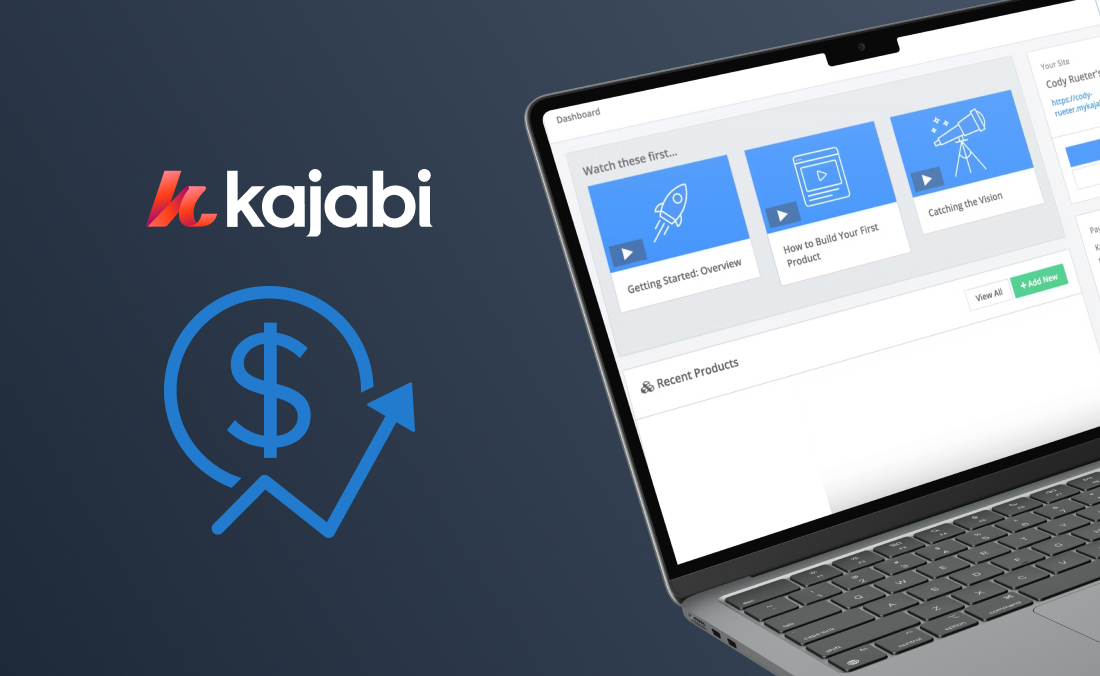Small businesses often struggle with building customer relationships. A visit to your website or store location is just the beginning; your success depends on how well you build an ongoing relationship with that ideal customer. First, you must attract the right clientele, and then you must guide them along a sales funnel until they trust you enough to make a purchase. A lead magnet is the perfect tool for building your customer list and earning their loyalty. With the right lead magnet, you’ll gain high-quality leads that will convert more easily to paying customers.
What is a Lead Magnet?
A lead magnet is an enticing offer designed to get a potential customer’s contact information so you can add them to an email marketing list. Strategically placed in landing pages or pop-ups, a lead magnet is often the starting point in a carefully crafted sales funnel that nurtures a relationship between your business and a future customer. There are many types of lead magnets — from coupons to time-saving templates or even an email course.
While lead magnets are popular with large retailers and B2B consulting businesses, they can also supercharge marketing efforts for other businesses. Have you ever visited the food court or walked around a farmer’s market and seen the vendor offering free samples? That’s a great example of a real-life lead magnet. We tend to think of them as digital only, but lead magnets can be used by restaurants, interior designers, mechanics, and virtually every type of business.
Planning an Effective Lead Magnet
To find the best lead magnet ideas for your business, it’s critical to spend time researching your audience and determining precisely what marketing strategy will appeal to them. Which of your pages or blog posts receive the most website visitors? Which of your products or services (or your competitors’) are most popular?
Information like this is a good indicator of what type of content or giveaway your new leads might be interested in. Use these details to craft a great lead magnet that is relevant to your specific audience, contains a high-value offer, and feels so exclusive they won’t hesitate to opt into your email list.
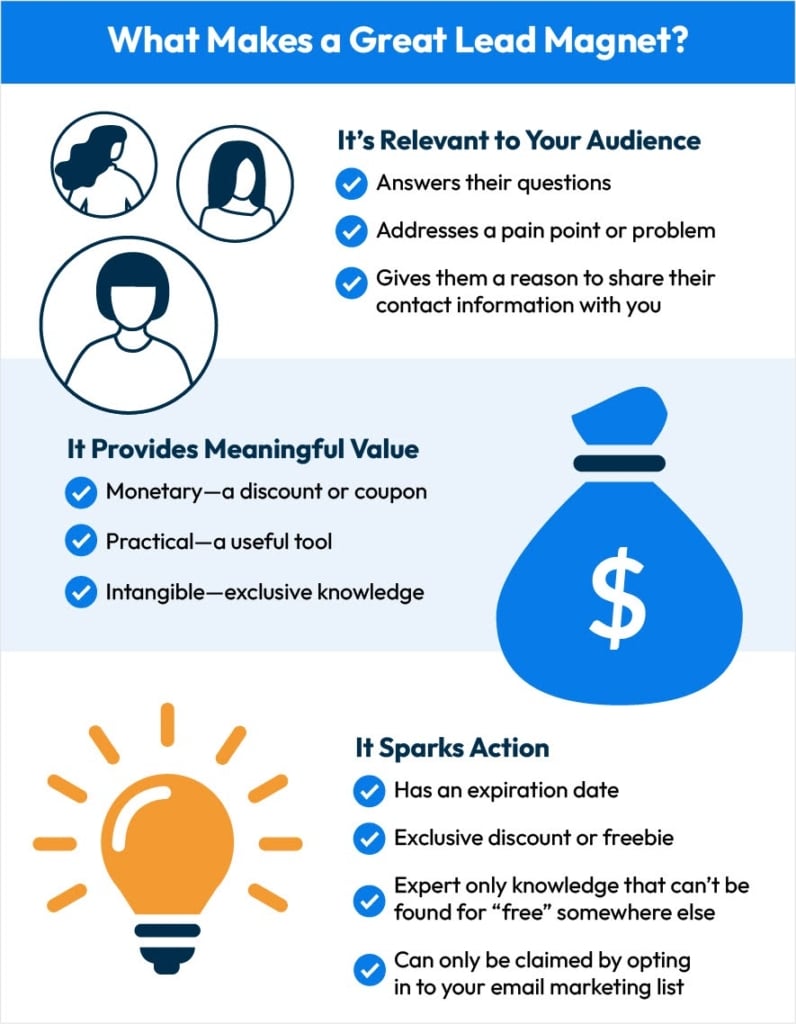
Is it relevant to my audience?
Remember, a lead magnet is not about you! An excellent lead magnet is specifically designed to engage potential customers who are the right fit for your business. Once you’ve decided which topic or products will grab website visitors’ attention, it’s time to figure out what your target audience’s specific challenges are.
- What questions do they ask before they start working with you?
- What are their pain points, or what problems do they want to solve?
- Why would someone exchange their contact information to receive your offer?
For example, homeowners often struggle with knowing where to start when they want to update their home. An interior designer’s lead magnet could be a free, 3-part email course on “How To Discover Your Home Decor Style”. This effective lead magnet addresses a common pain point and is relevant to a specific audience of prospective clients.”
Will it provide enough value to my customer?
The type of lead magnet you use will depend on the type of business you have; however, the value must be meaningful to your particular audience. There are three main reasons a lead magnet will appear valuable to a new lead:
- Monetary – discounts or coupons; for example, eCommerce stores offer first-time buyers a coupon in exchange for their email address.
- Practical – a useful free tool that can be put into immediate use, like a webinar planning toolkit, a meal plan, or a PDF checklist.
- Intangible – knowledge-based free resources like a whitepaper, a webinar, a free course, or creative ideas they can implement. A valuable offer contains high level or exclusive knowledge.
If your lead magnet is just a freebie that can be found anywhere, chances are it won’t be valuable enough to prospects to get their information.
Is it exclusive enough to spark action?
An offer’s exclusivity is a critical marketing tool because it puts pressure on the new lead to take action before they lose the opportunity. A good lead magnet uses these three methods to convince your audience that your offer is exclusive:
- It has an expiration date that will happen soon.
- It contains in-depth knowledge or experience that can only be obtained from an expert and won’t be found for “free” elsewhere.
- The only way to get this particular piece of content or claim this offer is to opt in to your email marketing list.
If your lead magnet can meet all of these criteria, you’ll have a marketing asset that can bring in profitable customers for years to come.
How to Create a Lead Magnet
You might be wondering how creating a lead magnet actually works, particularly if you’re a small business owner who doesn’t happen to have a background in writing or design. After all, creating a high-quality lead magnet takes time and effort, and skills like copywriting and graphic design are required to produce content that is engaging, effective, and valuable to the customer. While some businesses can splurge on professional help, others prefer to take a more budget-friendly, DIY approach.
There are plenty of free and low-cost tools available to help small businesses create the very best lead magnets possible. Let’s take a look:
Free Resources
These tools offer free templates that even beginners can use to create graphics and images, worksheets, printable PDF documents, slideshows, and presentations.
Canva: Offers free templates, images, and custom fonts to design all types of digital assets; create a PDF lead magnet with their free PDF Maker or make a slideshow with their Slideshow Maker.
Google Docs: Start with a free template from the Docs Template gallery.
Google Slides: Create presentations and slide decks with Slides Templates.
Chat GPT: Free AI tools can be helpful for research and idea generation. Use this as a springboard as you develop content that demonstrates your expertise.
Low-Cost Resources
Jump-start your lead magnet design with downloadable, plug-and-play templates or kits that include graphics images and fonts. Customize a template with your own brand and content. These low-cost resources offer more variety and more professional results than free resources.
Canva Pro: In addition to Canva’s free resources, Canva Pro offers a larger selection of templates, video editing tools, and access to an extensive stock photo and video library.
Creative Market: An affordable place to purchase original designs from independent graphic designers including graphics, illustrations, photos, mockups, and lead magnet templates.
Etsy: Buy original designs from independent graphic designers including graphics, illustrations, photos, mockups, toolkits, and lead magnet templates.
Professional Resources
Hire a graphic designer or marketing expert to design your lead magnet and a professional copywriter or editor to polish the content for an effective campaign.
Upwork: Post your project on Upwork as a freelance job listing or browse professional profiles to find the right people for your team.
Fiverr: List your project on Fiverr for freelancers to bid on or contact a freelancer or two who have the right skills.
Setting Up a Landing Page for Your Lead Magnet
Before you create a landing page, it is important to know its specific goal. This will guide both your content and call to action (CTA). Landing pages are also known as squeeze pages because they narrowly focus the visitor on your goal and push them to take action. A great landing page contains the following elements:
- Headline: Your headline should make the offer in a clear, concise, and engaging way.
- Value Proposition: A short statement explaining the benefits of claiming your offer, written to appeal directly to your target audience. What will they gain? What problems will your offer solve?
- Offer: Explain exactly what the customer will receive. What makes your offer stand out from the competition? Include details that will help them overcome any hesitations they may have. Reinforce your copy with images or graphics.
- Social Proof: Testimonials, customer logos, and reviews offer proof that other people have acted on your offer and agree that it has value. This instills trust and convinces your leads to accept the offer.
- Call to Action: Close the deal by clearly asking your lead to take a specific action such as clicking a button or entering their email address and phone number.
- Lead Capture Form: Provide a simple form for prospective customers to enter their information; follow up with a Success Page that confirms the signup.
- A/B Test: Create two different versions of your landing page testing a variable such as the headline, CTA, or image. Marketing software with A/B testing capabilities can compare the results of each page to determine which is most effective at lead generation.
Promoting Your Lead Magnet
Your lead magnet will only work if potential customers learn about it and see your call to action. Your digital marketing research will indicate where your target audiences can typically be found. Target these locations with a mix of marketing tactics — and remember, a potential lead may need to see your offer several times before taking action, so cross-posting is essential. Here are the most popular ways to promote your lead magnet:
- Website: Your own website is attracting traffic, and many of those visitors are potential customers. Add a CTA to your home page or a permanent footer that will appear across the site. You can also add a CTA to the end of every blog post to target visitors who may not see the home page.
- Social Media: Reach your target audience where they spend time online with a combination of social media posts and paid advertising.
- Email Marketing: If appropriate, promote your offer to existing customers on your email list. You can also purchase mailing lists of potential leads. Be sure to follow best practices and include an option to unsubscribe.
- Content Marketing: Blog posts and social media content like images and videos support brand recognition and introduce your brand to potential new leads — who can then be served ads for your lead magnet.
- Advertising: Paid advertisements can find your target audience across multiple channels including YouTube, Instagram, Facebook, podcasts, and news media.
Measuring Your Lead Magnet’s Success
Once you’ve launched your lead magnet, it’s crucial to measure its KPIs (key performance indicators) so you can make improvements if necessary. A few of the most important KPIs are the volume of leads you obtain, the quality of those leads, the lead magnet’s conversion rate, and the feedback you receive.
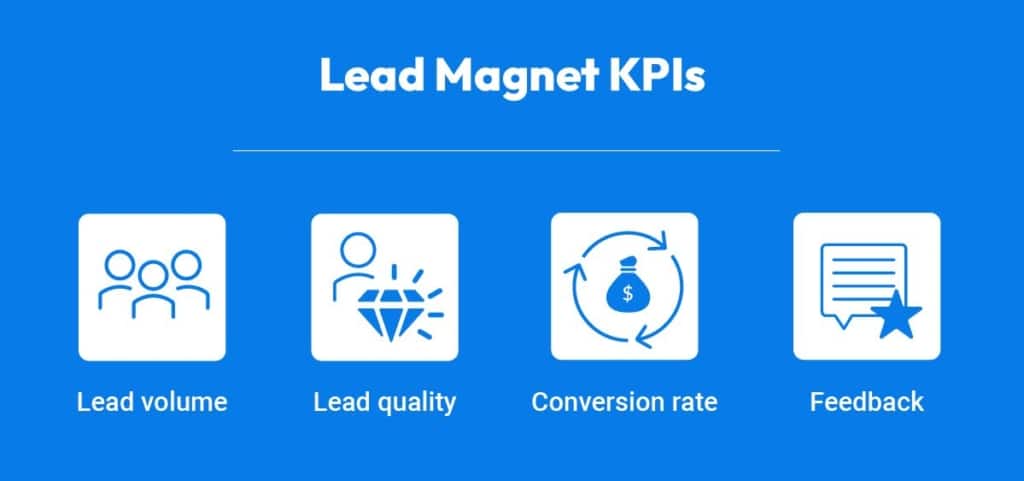
Lead Volume
The overall number of leads signing up for your offer is a good initial indicator of your lead magnet’s performance. While the landing page should bring in visitors on its own, it must be supported by paid and organic traffic from other sources to increase the volume of potential leads.
Analytics can tell you where the visitors to your landing page are coming from. If most of them click through from an ad, your landing page probably needs SEO (search engine optimization) improvement to increase organic traffic. If visitors are coming from other pages on your website, working to increase their ranking will boost your landing page. Because it takes time for a new page to rank, it’s important to measure and leverage your landing page traffic to maximize the volume of new leads.
Lead Quality
Tracking lead quality — not just quantity — is necessary to fine-tune your marketing efforts. A high bounce rate and a low conversion rate indicate that your offer is not relevant to the page’s visitors.
If you pay to bring traffic to the landing page, low-quality leads waste your budget. Either your marketing campaign isn’t targeting the right audience, or the messaging and offer are not as effective as they need to be. To attract better quality leads, you may need to change the offer, reconsider the audience, or rewrite the content.
Conversion Rate
The conversion rate for your lead magnet is the percentage of total page visitors who convert, or accept your offer and provide their information. While the standard of success for conversion rates varies from one industry to another, a ratio below 2% is cause for concern.
Low bounce rates on the landing page do indicate that you’ve attracted an interested audience; however, if the page also has a low conversion rate, then your offer does not provide enough value to close the deal. It’s time to reconsider the details of your offer or write more compelling sales copy to increase the conversion rate.
Feedback
Customer feedback is also key to understanding how well your marketing efforts are connecting with potential customers. Once a new lead has accessed your offer, follow up and ask for feedback about the lead magnet. Was it helpful? Did they find it valuable? You can also use a survey to find out what other types of content or products new leads like to receive. When it comes to making data-driven marketing decisions, the more information you have, the better.
10 Real-Life Successful Lead Magnet Examples
There are many options available when choosing a type of lead magnet, but most people rely on tried and true offers that are proven to work. Small businesses especially benefit from a good lead magnet’s ability to establish a solid, trusting relationship with a new customer. Depending on your type of business, these popular lead magnets may work for you:
1. Discount or Coupon
Discounts and coupons have an immediate impact and are very popular among a wide variety of small businesses that sell digital products, physical products, or both. These offerings have the dual benefit of gaining leads for marketing and bringing customers into the business. Often presented as a limited-time deal, a monetary incentive is a uniquely persuasive lead magnet.
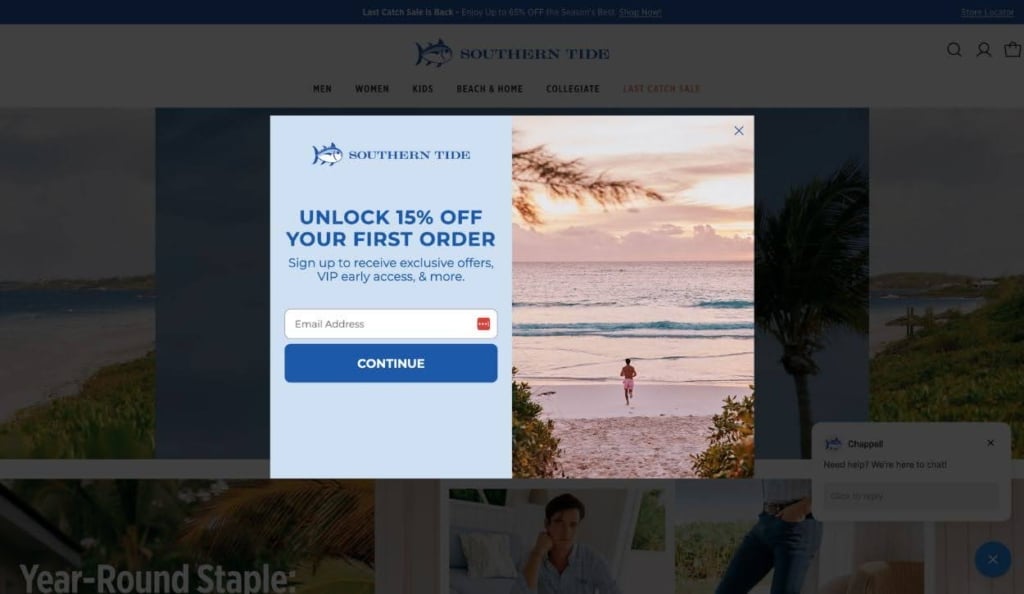
Southern Tide offers15% Off:https://southerntide.com/
2. Webinar
Webinars are an excellent way to promote your expertise, provide training, or demonstrate a complex product. They allow for in-depth presentations and can serve as a free introduction for anyone selling an online course.

Boss Babe Influencer Masterclass: https://go.bossbabe.com/influencermasterclass
3. Quiz or Assessment
Quizzes and surveys not only collect information that’s useful in marketing, they also help to convince a potential customer that they need your product or service. Customer assessments are a very effective marketing tool for industries such as fitness and fashion.

Parker Practice health quiz: https://theparkerpractice.com/quiz/
4. eBook or Whitepaper
A free eBook or whitepaper should provide helpful information such as a how-to guide or professional solutions to a common problem. This type of content is an excellent way to establish your business as an expert in your field. EBooks and whitepapers are particularly popular with real estate agents, consultants, and other businesses who have a lot of detailed information to convey.

Grant Cardone “Real Estate Wealth” Free eBook: https://cardonecapital.com/free/
5. Free Trial or Demo
A free trial or demonstration period is an ideal lead magnet for online coaches, SaaS companies, or consultants who profit from putting their content behind a paywall. Depending on the price point and commitment level of your product or service, a free trial or demo can make all the difference in persuading a customer of your value.
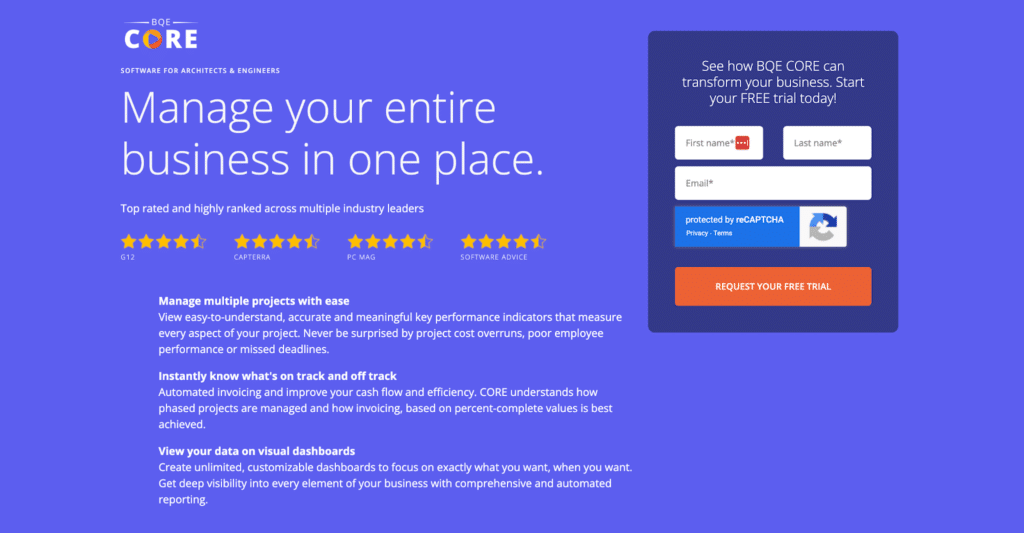
The Novelry free trial: thenovelry.com/free-trial
6. Checklist or Cheat Sheet
Time-saving shortcuts and insider tips have real value to your potential customers. With a little creativity, they can be used in almost any industry. This type of lead magnet includes anything from house-cleaning and travel-packing checklists to cheat sheets that help moms, teachers, or entrepreneurs become more efficient.
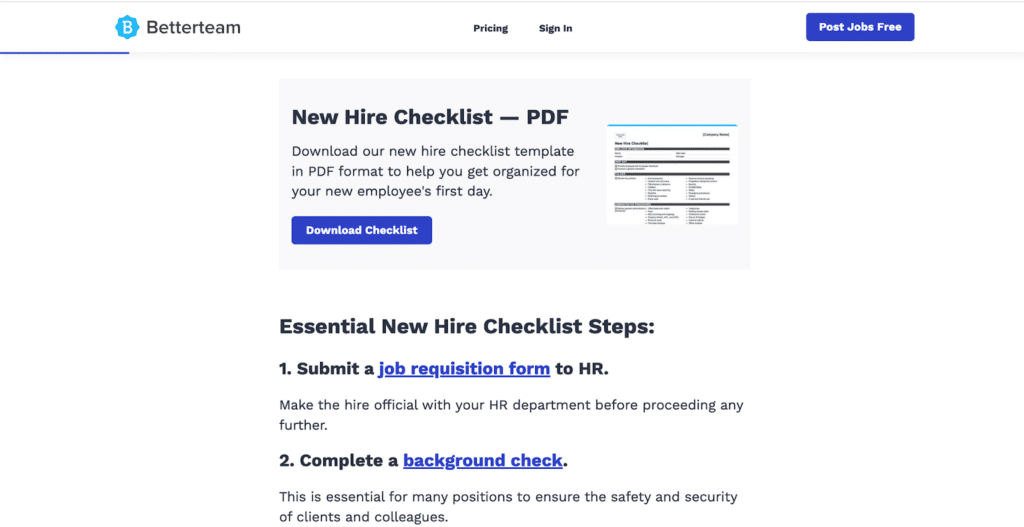
Betterteam new-hire checklist: betterteam.com/new-hire-checklist
7. Templates or Resource List
Free templates and resources offer immediate value to your new lead while introducing them to your other paid products. For example, many graphic designers sell templates that non-designers can use to create websites, resumes, or art. Free downloads and printables make great tangible offers for a lead magnet.

WebinarJam webinar planning template: genesisdigital.kartra.com/page/AHm2194
8. Visual Content
Visual content is a powerful means for attracting potential customers and encompasses a wide range of content types — including diagrams, charts, infographics, online videos, and slide decks. Visual content provides value because it can pack a lot of useful information into a compact presentation. A fitness coach can use a video to explain a training plan. An accountant might create a slide deck to walk through various retirement plans. If customers save and refer back to the information later, your business will stay on their radar.
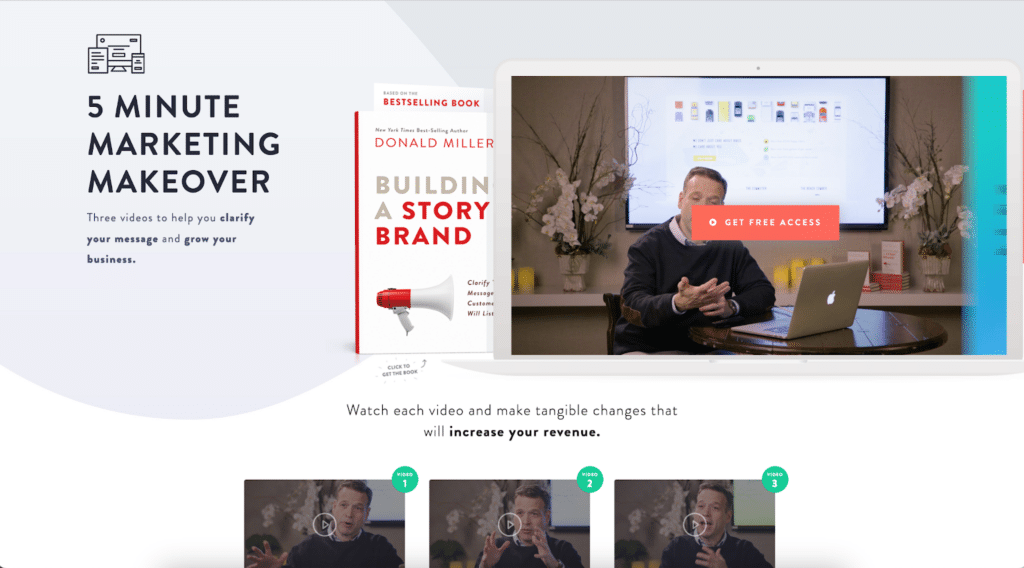
Strorybrand free video series: 5minutemarketingmakeover.com
9. Case Study or Testimonial
Social proof is a powerful selling tool when combined with proven expertise. A case study or testimonial shows your potential clients exactly what they can expect from your company based on another’s experience. Plus, the case study makes a tempting offer because it may include free ideas that a prospective client can use on their own.
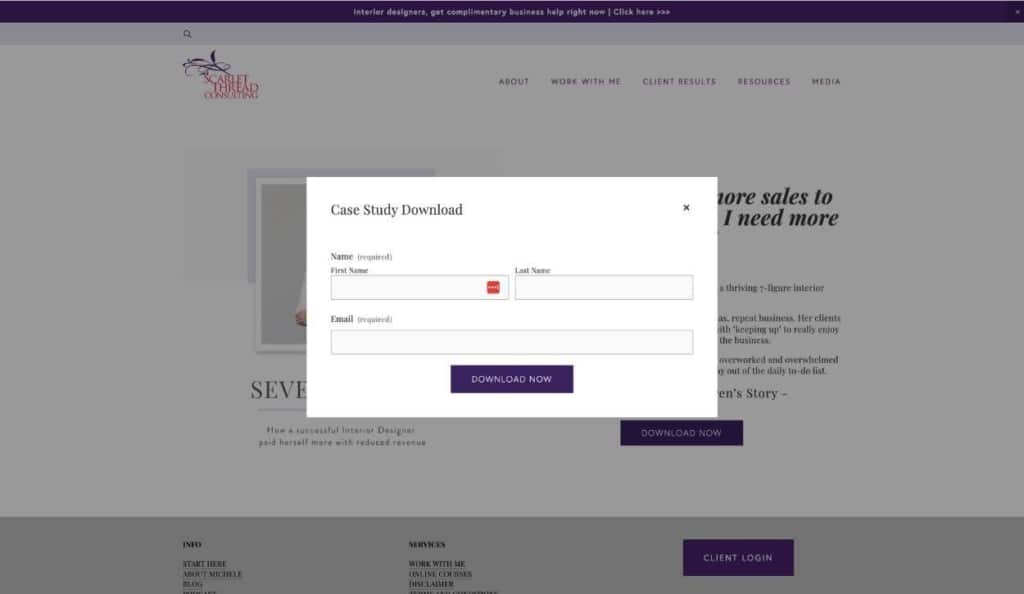
Scarlet Thread Consulting case study: scarletthreadconsulting.com/7-figure-case-study
10. Free Consultation or Strategy Session
If you offer a professional service, a free session will provide real value to your new lead and facilitate one-on-one interaction that can get you hired. Nutritionists, interior designers, business coaches, and therapists are just a few examples of experts who can benefit from providing an initial consultation and assessment at no charge. A free session allows you to fully assess the client’s needs and offer a plan of action to be implemented once you are hired.

Small Business Coach Associates free strategy session: smallbusinesscoach.org
Nurture and Convert Leads with Kartra All in One Software
You don’t need a degree in marketing to communicate with customers. You also don’t need dozens of software applications for each marketing task and channel. You just need one system that will integrate your marketing and sales processes, giving you insight into what’s working and letting you easily tweak what’s not. Business owners who use Kartra gain access to a comprehensive slate of marketing and sales tools for every stage of the customer journey, including:
- Hundreds of professional landing page and form templates
- Sales funnel templates and automation
- Membership management
- Cross-channel analytics
Grow your online business with Kartra’s comprehensive marketing and sales features.
About Kartra
This blog is brought to you by Kartra, the all-in-one online business platform that gives you every essential marketing and sales tool you need to grow your business profitably – from sales pages and product carts to membership sites, help desks, affiliate management and more. To learn how you can quickly and easily leverage Kartra to boost your bottom-line, please visit kartra.com.

